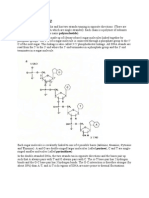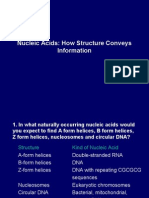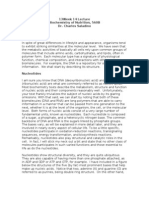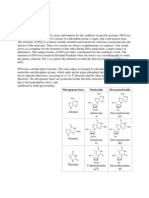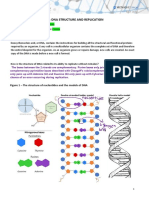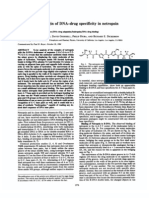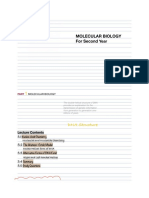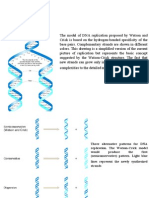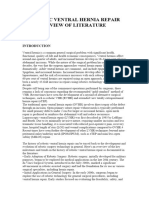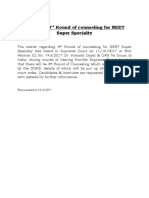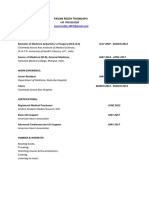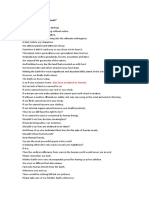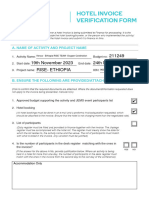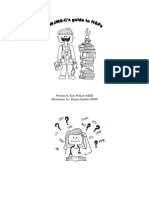Dna Structure
Dna Structure
Uploaded by
honeyworksCopyright:
Available Formats
Dna Structure
Dna Structure
Uploaded by
honeyworksOriginal Description:
Copyright
Available Formats
Share this document
Did you find this document useful?
Is this content inappropriate?
Copyright:
Available Formats
Dna Structure
Dna Structure
Uploaded by
honeyworksCopyright:
Available Formats
DNA Structure: A-, B- and
Z-DNA Helix Families
David W Ussery, Danish Technical University, Lyngby, Denmark
Introductory article
Article Contents
. Introduction
. Phosphate Backbone
. Base Pairs
There are three major families of DNA helices: A-DNA, B-DNA and Z-DNA. The helical
structure of DNA is variable and depends on the sequence as well as the environment.
. Structural Properties of the DNA Helix
. Right-handed Helices
. Left-handed Z-helices
Introduction
. Biology of A-, B-and Z-DNA
Pictures of the double helix of deoxyribonucleic acid
(DNA) have become so common that everyone is familiar
with its overall shape and structure (Figure 1a).This
structure is known as B-DNA, and represents an average
conformation of DNA, based on bre diraction studies.
However, this average shape of DNA is very unlikely to
exist within the cells of living organisms, for several
reasons. First, there is simply not enough room for the
DNA to be stretched out in a perfect, linear B-DNA
conformation. In nearly all cells, from simple bacteria
through complex eukaryotes, the DNA must be compacted
by more than a thousandfold in order even to t inside the
cell or nucleus. Furthermore, rened resolution of the
structure of DNA, based on X-ray crystallography of short
synthetic pieces of DNA, has shown that there is
considerable variance of the helical structure of DNA,
. Acknowledgements
. Summary
based on the sequence. For example, a 200-bp piece of
DNA can run as if it were more than 1000 bp on an
acrylamide gel, if it has the right sequence. The double helix
is not the same uniform structure. The structure (and
function) of DNA depends on the sequence of the DNA.
There are three families of DNA helices: A-DNA, which
can readily form within certain stretches of purines (e.g.
GAGGGA); B-DNA, which is favoured by mixed
sequences (although the exact conformation depends on
the particular nucleotide sequence, as described below);
and Z-DNA, which is favoured by alternating pyrimidine
purine steps (e.g. CGCGCG). The A-and B-DNA families
are right-handed helices, while the Z-DNA family has a
Figure 1 Different views of the DNA helix. (a) The structure of B-DNA as proposed by Watson and Crick in 1953, based on fibre diffraction studies.
Modified from Sinden et al. (1998). (b) A-, B-and Z-DNA, as seen from the side of the helix (above), and looking down the helix axis (below). The structures
were drawn from the crystal structures, using the Cn3D programme, available from the NCBI home page.
ENCYCLOPEDIA OF LIFE SCIENCES / & 2002 Macmillan Publishers Ltd, Nature Publishing Group / www.els.net
DNA Structure: A-, B- and Z-DNA Helix Families
left-handed orientation of the helix, as shown in Figure 1b.
These dierent conformations of the DNA helix have
important biological functions.
Phosphate Backbone
Phosphodiester backbone
The phosphate backbone consists of deoxyribose sugar
molecules linked together by phosphate groups, as shown
in the oligonucleotide in Figure 2. The backbone continues
on in a simple repetitive pattern:
base
base
phosphate sugar phosphate sugar phosphate sugar
base
with the DNA bases sticking out at the side. The
phosphate groups have a negative charge, giving the
outside of the DNA an overall negative charge. This charge
is neutralized in solution by Na+, although in the cell
(where much less Na+ exists), the polyamines spermine
and spermidine bind along the phosphate backbone and
help neutralize some of the charge. (The charge is also
neutralized by divalent cations, such as Mg2 1 , and many
DNA-binding proteins often contain the positively
charged amino acids lysine and arginine, which are
attracted to the negatively charged phosphate backbone.)
5 to 3 direction of DNA sequences
There is a biological reason for the convention of always
writing DNA sequences in the 5 to 3 direction. In part
because of the structure of the starting material (nucleotide
5 triphosphates), the enzymes inside cells which copy the
DNA (e.g. DNA and RNA polymerase) always synthesize
in the direction 5 to 3. The strands in DNA are
antiparallel; that is, they go in opposite directions.
The numbering for the ring carbon and nitrogen atoms is
shown in Figure 2a; note that the six-membered rings of the
bases are numbered in a counterclockwise direction,
starting with a nitrogen. In order to distinguish numbering
of the sugar carbon atoms from that of the bases, the sugar
carbons are numbered with a prime (), starting with the
atom which is connected to the base, and continuing
around the sugar ring, away from the oxygen atom. Thus,
as can be seen in Figure 2, for the deoxyribose sugars there
are phosphate atoms connected to the oxygen atoms
adjacent to the 3 and 5 carbon atoms. In order to have a
direction, one has to look at the ends. The top end in
Figure 2b has a 5 phosphate on it, and this is called the 5
end, while the other end has a 3 hydroxyl (OH) on it, and is
called the 3 end. Thus, the sequence in Figure 2b would be
read as (5) ACGT (3), and it is important to note that
TGCA would be a dierent DNA sequence.
2
Base Pairs
Base-stacking interactions
From an energetic point of view, the most important
contribution to the DNA helix is the stacking of the bases
on top of each other. The stacking energy is a measure of
how much energy is required to destack or melt a region of
double-stranded DNA. Table 1 lists the stacking energies
for all 16 dierent dinucleotide combinations. There is a
strong sequence dependence on the amount of stabilizing
energy from base stacking. As a general trend, alternating
pyrimidinepurine steps have less energy, and in particular
T.A steps have the lowest ( 2 3.82 kcal mol 2 1). G.C steps
have the largest value ( 2 15 kcal mol 2 1), and require the
most energy to melt.
The propeller twist is a measure of the angle between the
planes of the two bases, as shown in Figure 3b. Each base is
planar, but when two bases pair, they do not always line up
perfectly at with each other; this angle is called propeller
twist because the bases are twisted away from each other
like an aeroplane propeller. This measure is related to the
rigidity of the helix, such that a larger propeller twist angle
reects a more rigid helix. In B-DNA, the propeller twist
angles are usually quite low, as can be seen from the side
view of the helix in Figure 1b.
Another important dinucleotide parameter related to
base-stacking interactions is the twist angle of the two
bases, as shown in Figure 3b. Table 1 includes the values for
twist angles for B-DNA in solution. Note that these range
from 27.98 (which would correlate to a helix with 12.9 bp
per turn) to 408 (corresponding to 9 bp per turn). Thus the
pitch of the helix (that is, the length of a full turn of the
helix) can range considerably, based on the sequence. This
has important biological consequences. If there are two
protein-binding sites, each facing the same side of the helix,
separated by about 21 bp, or roughly two turns of the helix,
it is possible to have dierent intervening sequences,
resulting in quite dierent orientations of the two sites
(ranging over about 458 of orientation relative to each
other).
WatsonCrick base pairing
There are four dierent DNA bases: A (adenine), C
(cytosine), G (guanine) and T (thymine). Two of the bases
(C and T) contain only one ring (see the chemical structures
in Figure 3), and are called pyrimidines. The other two bases
(A and G) contain two rings, and are known as purines.
Within DNA the bases pair by complementary base
pairing, as in the WatsonCrick base pairs shown in
Figure 3a. Note that there are two hydrogen bonds for an
A.T base pair, and three hydrogen bonds for a G.C base
pair. Hydrogen bonds (H-bonds) are weak, and in DNA,
the hydrogen bonds have only about 2 kcal mol 2 1 energy.
ENCYCLOPEDIA OF LIFE SCIENCES / & 2002 Macmillan Publishers Ltd, Nature Publishing Group / www.els.net
DNA Structure: A-, B- and Z-DNA Helix Families
N
C
N
C
H
O
5C
4C
1
2
8C
O
5
P
O
CH2
O
H
H
(a)
HO
Adenine
N
H
C
O
O
H
CH2 O
H
H
Cytosine
5 Phosphate end
H
O
H
O
O
O
O
CH2 O
H
N
O
O
Negatively charged
phosphate backbone
Guanine
H
N
H
CH2 O
H2C
H
H
Thymine
O
O
O
CH2 O
O
H
(b)
3 Hydroxyl end
O
H
Figure 2 Chemical structure of DNA. (a) The chemical structure of the nucleotide adenosine triphosphate (ATP). (b) The phosphodiester backbone for the
sequence d(ACGT). Modified from Sinden et al. (1998).
ENCYCLOPEDIA OF LIFE SCIENCES / & 2002 Macmillan Publishers Ltd, Nature Publishing Group / www.els.net
DNA Structure: A-, B- and Z-DNA Helix Families
Dinucleotide values for helical parameters for B-DNA
Table 1
Dinucleotide
step
Stacking energy
kcal mol1
AA
AC
AG
AT
CA
CC
CG
CT
GA
GC
GG
GT
TA
TC
TG
TT
Average
Twist angle
()
5.37
10.51
6.78
6.57
6.57
8.26
9.61
6.78
9.81
14.59
8.26
10.51
3.82
9.81
6.57
5.37
7.92 2.57
Major groove
35.6
34.4
27.9
32.1
34.5
33.7
29.8
27.9
36.9
40.0
33.7
34.4
36.0
36.9
34.5
35.6
35.7 8.0
18.66
13.10
14.00
15.01
9.45
8.11
10.03
14.00
13.48
11.08
8.11
13.10
11.85
13.48
9.45
18.66
12.60 3.2
Propeller twist
()
N
+
N
N
Sugar
Sugar
Propeller twist
Minor groove
Major groove
H
CH3
N
N
N
N
Sugar
N
N
O
Sugar
Twist
(a)
Minor groove
(b)
Figure 3 Properties of DNA bases. (a) The base pairs for guaninecytosine (G.C) and adeninethymine (A.T). (b) Twist angle for the A.A dinucleotide,
and propeller twist for an A.T base pair. Modified from Sinden et al. (1998).
ENCYCLOPEDIA OF LIFE SCIENCES / & 2002 Macmillan Publishers Ltd, Nature Publishing Group / www.els.net
DNA Structure: A-, B- and Z-DNA Helix Families
This is likely to be due in part to propeller twisting of the
bases (Figure 3b), which results in strain in the H-bonds.
Other forms of base pairing
Ideally, the base pairing should always be of the Watson
Crick type, although other types of base pairing are
possible. For individual nucleotide bases (not conned by a
double helix), there are several choices of pairing available.
It is possible to rotate one of the bases and obtain reverse
WatsonCrick bonding. Another form of base pairing is
known as Hoogsteen base pairs, but in this conformation
the G.C base pair is stable only under slightly acidic
conditions (pH 45), due to the necessary protonation of
cytosine. These are only examples of many alternative
forms of base pairing in DNA; most are rare, but could be
induced by changes in the environment (e.g. low pH), and
the result of the dierent base pairing would be mutations
in the newly replicated DNA sequence.
The WatsonCrick form of base pairs have the same
width for A.T, T.A, G.C and C.G base pairs, and they all
readily t within the phosphate backbone of the DNA
double helix. It is worth noting that some DNA repair
enzymes scan the DNA, checking the width of the helix for
any bulges (likely due to purinepurine base pairs) or dips
(perhaps due to pyrimidinepyrimidine base pairing).
Also, the reverse WatsonCrick and other forms of
alternative base pairing within the context of duplex
DNA is likely to result in a distortion of the helix, which the
repair enzyme might be able to detect.
Structural Properties of the DNA Helix
Why is DNA a helix?
The tendency towards a helix comes from the stacking of
the individual bases on top of one another. Both the sugar
and phosphate which constitute the backbone are quite
soluble in water. However, the DNA bases which are in the
middle of the helix are relatively hydrophobic and
insoluble. For example, one could readily dissolve more
than 500 g of deoxyribose sugar in a litre of solution, and
more than 100 g of phosphate will also readily dissolve in
the same volume. Only half of a single gram of adenine will
dissolve in a litre of water. Since the bases are at, they
stack on top of each other in order to form a more
hydrophobic mini-environment. The bases twist slightly
in order to maximize their hydrophobic interactions with
each other, and it is this twisting of the stacked bases that
gives rise to a helix. Free adenine molecules, on their own,
will spontaneously stack on top of themselves to form
single-stranded helices in solution! Thus the reason for a
helix in DNA is primarily due to the hydrophobic stacking
interactions of the bases.
Major and minor grooves
The B-DNA major groove is labelled in Figure 1a. The terms
major groove and minor groove are based on the two
grooves of the WatsonCrick B-DNA structure. Although
the dimensions of the major and minor grooves are
dierent for the three dierent helix families, from the
point of view of the bases, the major groove is always on the
same side for a given base pair. Note that the sugars
(Figure 3a) are closer to one side of the base pair than the
other. There is less space on the side between the sugars
(lower side of the base pair in Figure 3a). The convention is
that the side closest to the sugars is called the minor groove
side.
For B-DNA helices, proteins binding in the major
groove usually bind to specic sequences, often through
the insertion of an a helix into the major groove. In
addition, the major groove of B-DNA is approximately the
correct width to accommodate a third base pair (usually a
pyrimidine), as happens in certain triplex DNA structures.
Proteins that bind DNA nonspecically (such as
chromatin proteins) will often bind DNA in the minor
groove, through interactions with a protein b strand. In
addition, water molecules and small ions can bind to, and
stabilize, the minor groove. In A-DNA, the minor groove is
almost the same size as the major groove, while in Z-DNA,
the minor groove is deep and narrow, and the major groove
is almost nonexistent.
Right-handed Helices
A-DNA
A-form DNA was rst identied from bre-diraction
studies of DNA at low (75%) relative humidity. More
recently, crystal studies have identied specic sequences
which can adopt A-DNA type of structures (Figure 1b). In
general, A-DNA for any sequence is favoured under
dehydrating conditions, and certain purine stretches will
favour an A-conformation, even in cases of higher
hydration levels. It appears that at least four purines (or
pyrimidines) in a row are enough to set up a local A-DNA
helix, although of course certain purine stretches are more
likely to form A-DNA than others. (For example, the
sequence AAAA crystallizes as B-DNA, not in the Ahelix.) It is thus possible to have a DNA sequence that
contains some regions in the A-form within the context of a
mainly B-conformation.
Some of the helical parameters of A-DNA are given in
Table 2. The A-DNA helix is a bit wider than B-DNA (and
also Z-DNA), and this is mainly due to the fact that the
base pairs stack nearly on top of each other in B-DNA, but
stack a little o-centre in the A-conformation. Notice in
Figure 1b that, if you look down the helix, there is a hole in
the A-conformation, which is absent in the two other
ENCYCLOPEDIA OF LIFE SCIENCES / & 2002 Macmillan Publishers Ltd, Nature Publishing Group / www.els.net
DNA Structure: A-, B- and Z-DNA Helix Families
Table 2
Comparison of different helical parameters for A-, B-, and Z-DNA
Parameter
Helix sense
Base pairs per turn
Axial rise (nm)
Helix pitch ()
Base pair tilt ()
Twist angle ()
Diameter of helix (nm)
A-DNA
Right
11
0.26
28
20
33
2.3
helical conformations. As might be expected, this results in
the A-DNA helix being less stable than the B-DNA
conformation. A-DNA is also more rigid than B-DNA,
again because the o-centre stacking of the bases makes
them less exible. There are about 11 bp per turn for ADNA, compared with about 10 bp per turn for the B-form.
Finally, the base-pair tilt is higher in A-DNA than in BDNA. An A-helix is the common form for DNARNA
hybrids, as well as double-stranded RNA; this is due to the
extra OH group on the ribose sugar, which cannot t easily
into the tight space allotted to it in B-DNA.
B-DNA
Right
10
0.34
34
6
36
2.0
Z-DNA
Left
12
0.45
45
7
30
1.8
most other sequences will readily form a right-handed
helix. The Z-helix is narrower than the A-and Bconformations, and it has 12 bp per turn. The nucleotide
bases are ipped upside down, relative to the phosphate
backbone, in Z-DNA when compared with A-DNA and BDNA.
Biology of A-, B-and Z-DNA
Biology of A-DNA
B-DNA
B-DNA is the WatsonCrick form of the double helix that
most people are familiar with (Figure 1). It was rst
identied in bres at 92% relative humidity. Several
sequences crystallized to high resolution have been found
to adopt the B-DNA conformation. Although on average
the conformation of B-DNA is the same in crystals as in
solution, the local structure is strongly dependent on its
local sequence. Table 1 lists some of the dierent structural
parameters for B-DNA as a function of dinucleotide
sequence. The table also shows the average parameters,
which are very close to the values obtained in bre
diraction studies. Of the three families of DNA helices,
B-DNA is the most common, and also the most variable in
structure.
Left-handed Z-helices
One of the rst DNA sequences to be crystallized was the
oligomer d(GCGCGC), as shown in Figure 1b. To many
peoples surprise, this structure was a left-handed helix,
opposite to that of the traditional WatsonCrick helix. The
backbone is not a smooth helix, but is irregular and zigzag
in shape, hence its name. At the time, this structure was
quite controversial, but now it is generally accepted that
certain DNA sequences (in particular alternating purine
pyrimidine tracts) can form left-handed Z-DNA, while
6
A-form helices are common for DNARNA hybrids, as
well as for double-stranded RNA; in addition, the Aconformation is favoured in triplex DNA. A transition
from B-DNA to A-DNA has been postulated to occur
during transcription, where the RNADNA hybrid would
be more stable in the A-conformation. A-DNA also plays a
role in some processes that do not involve RNA. For
example, in sporulating bacteria, there is a protein which
can bind to DNA in the B-conformation and induce a
change to the A-DNA helix. Another common biological
occurrence of sequences which can readily form A-DNA is
in the long terminal repeats (LTRs) of transposable
elements. These regions often contain purine stretches
which favour the A-DNA conformation. In fact, the DNA
sequence used for the crystal structure sequence of A-DNA
shown in Figure 1b is from an LTR of the human
immunodeciency virus. It is likely that these regions are
involved in recombination. Short stretches of purines
which are likely to form A-DNA conformations exist in
genomes in much greater abundance than would be
expected from the mononucleotide composition, ranging
from about a fourth of the genome in bacteria to close to
half the DNA in eukaryotic chromosomes.
Biology of Z-DNA
Sequences which can form Z-DNA are essentially not
found in Escherichia coli, and yet they are overrepresented
in complex eukaryotes. A notable example of this is the
ENCYCLOPEDIA OF LIFE SCIENCES / & 2002 Macmillan Publishers Ltd, Nature Publishing Group / www.els.net
DNA Structure: A-, B- and Z-DNA Helix Families
CpG islands, which could potentially form Z-DNA,
especially when methylated. In a complicated scenario, a
protein which is responsible for mRNA editing is activated
upon binding to left-handed Z-DNA upstream of a gene.
In addition, Z-DNA has also been postulated to play a role
as a transcription enhancer, and in terminal dierentiation.
In some eukaryotic genomes, 10% or more of the genome
contains sequences capable of forming Z-DNA.
B-DNA structure and function
As mentioned above, the structure of B-DNA is strongly
dependent on its sequence. Thus, some sequences which
can melt readily (e.g. TATA) can be strategically placed to
open the DNA helix for initiation of transcription. Other
sequences that are more rigid (or exible) can serve as sites
for protein binding and formation of specic complexes. In
bacteria as well as eukaryotes, sequences upstream of
transcription start sites contain regions which are more
rigid and will melt more readily. In addition to the three
dierent helical conformations of DNA, there are numerous other DNA structures, such as DNA curvature,
cruciforms, triple-stranded DNA, tetraplex DNA and
parallel-stranded DNA, that can be formed under various
conditions. Thus there is much more to DNA structure
than merely the WatsonCrick B-DNA conformation.
Summary
Whether a DNA sequence will be in the A-, B-or Z-DNA
conformation depends on at least three conditions. The
rst is the ionic or hydration environment, which can
facilitate conversion between dierent helical forms. ADNA is favoured by low hydration, whereas Z-DNA can
be favoured by high salt. The second condition is the DNA
sequence: A-DNA is favoured by certain stretches of
purines (or pyrimidines), whereas Z-DNA can be most
readily formed by alternating purinepyrimidine steps.
The third condition is the presence of proteins that can
bind to DNA in one helical conformation and force the
DNA to adopt a dierent conformation, such as proteins
which bind to B-DNA and can drive it to either A-or Zforms. In living cells, most of the DNA is in a mixture of Aand B-DNA conformations, with a few small regions
capable of forming Z-DNA.
Acknowledgements
This work was supported by a grant from the Danish
National Research Foundation.
Further Reading
Calladine CR and Drew HR (1997) Understanding DNA, 2nd edn. San
Diego, CA: Academic Press.
Centre of Biological Sequence Analysis (2001) http://www.cbs.dtu.dk/
dave/DNAbooks.html [A list of more than 100 books about DNA.]
Centre for Biological Sequence Analysis (2001) http://www.cbs.dtu.dk/
services/GenomeAtlas/A_DNA.html
Frank-Kamenetskii MD (1993) Unraveling DNA. Cambridge, UK:
VCH Publishers (UK) Ltd.
Gagna CE, Kuo H and Lambert WC (1999) Terminal dierentiation and
left-handed Z-DNA: a review. Cell Biology International 23: 15.
Herbert A and Rich A (1999) Left-handed Z-DNA: structure and
function. Genetica 106: 3747.
Malinia L, Fernandez LG, Huynh-Dinh T and Subirana JA (1999)
Structure of the d(CGCCCGCGGGCG) dodecamer: a kinked ADNA molecule showing some B-DNA features. Journal of Molecular
Biology 285: 16791690.
National Center for Biotechnology Information (2001) http://
www.ncbi.nlm.gov:80/entrez/query.fcgi?db=Structure [type in ADNA, for example, for a list of A-DNA crystal structures].
Ng H, Kopka ML and Dickerson RE (2000) The structure of a stable
intermediate in the A-DNA helix transition. Proceedings of the
National Academy of Sciences of the USA 97: 20352039.
Saenger W (1984) Principles of Nucleic Acid Structure. New York:
Springer.
Sinden RR (1994) DNA Structure and Function. San Diego: Academic
Press.
Sinden RR, Pearson CE, Potaman VN and Ussery DW (1998) DNA:
structure and function. Advances in Genome Biology 5A: 1141.
ENCYCLOPEDIA OF LIFE SCIENCES / & 2002 Macmillan Publishers Ltd, Nature Publishing Group / www.els.net
You might also like
- Indigo Boarding Pass SampleDocument1 pageIndigo Boarding Pass Samplehoneyworks50% (8)
- Sarfaraz Jalil Baig, Deepraj Bhandarkar, Pallawi Priya - Newer Concepts and Procedures in Hernia Surgery - An Atlas-Springer (2023)Document258 pagesSarfaraz Jalil Baig, Deepraj Bhandarkar, Pallawi Priya - Newer Concepts and Procedures in Hernia Surgery - An Atlas-Springer (2023)honeyworksNo ratings yet
- 78 Cosmetics GMP Audit ChecklistDocument3 pages78 Cosmetics GMP Audit Checklistsandeshkuperkar95No ratings yet
- Beyond Intellectual DingDocument21 pagesBeyond Intellectual DingAbraxas44480% (5)
- Unit Vi: Storage and Expression of Genetic Information DNA Structure, Replication, and Repair Qingsong WangDocument30 pagesUnit Vi: Storage and Expression of Genetic Information DNA Structure, Replication, and Repair Qingsong WangasaadsarfrazNo ratings yet
- Molecular Biology and Genetics Book 3 PDFDocument68 pagesMolecular Biology and Genetics Book 3 PDFPawan Gupta50% (2)
- TOFD PA Procedure For 301 PDFDocument49 pagesTOFD PA Procedure For 301 PDFwiNo ratings yet
- (PersonalityCentral) ENFJ CareerReportDocument12 pages(PersonalityCentral) ENFJ CareerReportWidasari WidaNo ratings yet
- DNA Structure - A-, B - and ZDocument7 pagesDNA Structure - A-, B - and ZAlexandraNo ratings yet
- Dna StructureDocument23 pagesDna StructureAnonymous mHS76aNo ratings yet
- DNA StructureDocument6 pagesDNA StructuremahasensationNo ratings yet
- Molecular Biology - IDocument122 pagesMolecular Biology - IBhanvi PaliwalNo ratings yet
- Components of RNA and DNADocument26 pagesComponents of RNA and DNAKarla Javier PadinNo ratings yet
- DNA StructureDocument7 pagesDNA Structurettaahhssiinn3No ratings yet
- DNA, Chromosomes, and GenomesDocument52 pagesDNA, Chromosomes, and GenomesunameNo ratings yet
- Events EventsDocument6 pagesEvents EventsOne TwoNo ratings yet
- Structure of DNA PDFDocument7 pagesStructure of DNA PDFJamesNo ratings yet
- Structural Biochemistry - DNADocument13 pagesStructural Biochemistry - DNAJenny MulicNo ratings yet
- DNA - RNA Structure, Replication and Protein Synthesis2 - 014640Document12 pagesDNA - RNA Structure, Replication and Protein Synthesis2 - 014640waltergaruba5No ratings yet
- Nucleic Acids.Q&A Part1Document102 pagesNucleic Acids.Q&A Part1dhainey80% (5)
- BME 203 - Lecture No. 13-15Document131 pagesBME 203 - Lecture No. 13-15SagorNo ratings yet
- DNA RNA+Structure+Handout+VER++BCH5413++Fall+2013+IIDocument25 pagesDNA RNA+Structure+Handout+VER++BCH5413++Fall+2013+IIRamya RallabandiNo ratings yet
- Chapter 3.2 MB DNA StruDocument62 pagesChapter 3.2 MB DNA StruMustee TeferaNo ratings yet
- Nucleic Acid (Organic Chemistry) : By: Septiana Saputri (1800023180)Document7 pagesNucleic Acid (Organic Chemistry) : By: Septiana Saputri (1800023180)septianasptrNo ratings yet
- Dna Replication - Dna RepairDocument27 pagesDna Replication - Dna Repairnokate konkoorNo ratings yet
- Structure of MoleculesDocument5 pagesStructure of MoleculesHanimNo ratings yet
- Week 14 Lecture 560B On LineDocument9 pagesWeek 14 Lecture 560B On LineTheNourishedSproutNo ratings yet
- 09NucAMO SuarezDocument14 pages09NucAMO SuarezscasuarezNo ratings yet
- Nitrogenous Base Nucleoside DeoxynucleosideDocument14 pagesNitrogenous Base Nucleoside DeoxynucleosideIan WongNo ratings yet
- Structural Biology 201 210Document10 pagesStructural Biology 201 210newic40029No ratings yet
- 2023 MBH 222 NoteDocument19 pages2023 MBH 222 Noteonwukapaul21No ratings yet
- Dna RnaDocument19 pagesDna RnaDianne Constantino ValdezNo ratings yet
- Charmaine and GabiDocument14 pagesCharmaine and GabiJessa Mae BanquirigNo ratings yet
- GGL DNA Replication PDF VersionDocument7 pagesGGL DNA Replication PDF VersionlloaanaNo ratings yet
- Nucleic Acid Double HelixDocument8 pagesNucleic Acid Double Helixjcampos79No ratings yet
- Nucleotides and Nucleic AcidsDocument29 pagesNucleotides and Nucleic AcidsTavonga ShokoNo ratings yet
- Nucleic Acid StructureDocument11 pagesNucleic Acid StructurenadirappNo ratings yet
- Handouts Unit-IVDocument11 pagesHandouts Unit-IVmukeshNo ratings yet
- Nucleic AcidsDocument42 pagesNucleic AcidsJulianne AnikaNo ratings yet
- PDF Reference2-Lesson10-DnaandchromosomesDocument3 pagesPDF Reference2-Lesson10-Dnaandchromosomesjg teNo ratings yet
- 09NucAMO MamalapatDocument7 pages09NucAMO MamalapatMohamidin MamalapatNo ratings yet
- And Distamycin: The Molecular Origin of DNA-drug Specificity in NetropsinDocument5 pagesAnd Distamycin: The Molecular Origin of DNA-drug Specificity in NetropsinYimei WenNo ratings yet
- Heredity DNA, RNA GenesDocument61 pagesHeredity DNA, RNA GenesIvan RamosNo ratings yet
- Lecture 3 - DNA Structure PDFDocument6 pagesLecture 3 - DNA Structure PDFАбу ДжудNo ratings yet
- DnaDocument3 pagesDnanurul taqinah ismailNo ratings yet
- Watson CrickDocument5 pagesWatson CrickIqra HamidNo ratings yet
- DNA Replication 2Document22 pagesDNA Replication 2api-3800279No ratings yet
- Levels of Structure of Dna PrimaryDocument2 pagesLevels of Structure of Dna PrimaryMaple DychitanNo ratings yet
- CH 29Document32 pagesCH 29IshNo ratings yet
- Chem 205 Lecture 5: Nucleotides and Nucleic Acids (Derived From Voet, 2011)Document37 pagesChem 205 Lecture 5: Nucleotides and Nucleic Acids (Derived From Voet, 2011)Rab BaloloyNo ratings yet
- Nucleic Acids1-1Document34 pagesNucleic Acids1-1HarshilPatelNo ratings yet
- Paper - IV Molecular BiologyDocument236 pagesPaper - IV Molecular BiologyNaruto UzumakiNo ratings yet
- DNAstruc 2001Document4 pagesDNAstruc 2001Surajit BhattacharjeeNo ratings yet
- HDTD-B-9 - Molecular Genetics IDocument25 pagesHDTD-B-9 - Molecular Genetics IMariam QaisNo ratings yet
- NAT SCI 9 Nucleic AcidsDocument12 pagesNAT SCI 9 Nucleic Acidskjgbitoon00125No ratings yet
- 022 - Protein Synthesis I - Nucleic AcidsDocument3 pages022 - Protein Synthesis I - Nucleic Acidslastjoe71100% (1)
- Dna & RnaDocument43 pagesDna & RnaheyyyaleNo ratings yet
- 12 - DNA & Replication QuestionsDocument3 pages12 - DNA & Replication QuestionsShevona PaulNo ratings yet
- Dna Structure: Structure of Dna. All Naturally Occurring Dnas Are Double-Stranded, For at LeastDocument5 pagesDna Structure: Structure of Dna. All Naturally Occurring Dnas Are Double-Stranded, For at LeastsushanfcriNo ratings yet
- DNA Topology Supercoiling and Linking PDFDocument5 pagesDNA Topology Supercoiling and Linking PDFmanoj_rkl_07No ratings yet
- TranscriptionDocument24 pagesTranscriptionAdultNo ratings yet
- Reordering Life: Knowledge and Control in the Genomics RevolutionFrom EverandReordering Life: Knowledge and Control in the Genomics RevolutionNo ratings yet
- Amorphous Semiconductors: Structural, Optical, and Electronic PropertiesFrom EverandAmorphous Semiconductors: Structural, Optical, and Electronic PropertiesNo ratings yet
- Carbon Nanomaterials for Bioimaging, Bioanalysis, and TherapyFrom EverandCarbon Nanomaterials for Bioimaging, Bioanalysis, and TherapyYuen Y. HuiNo ratings yet
- Stereoelectronic Effects: A Bridge Between Structure and ReactivityFrom EverandStereoelectronic Effects: A Bridge Between Structure and ReactivityNo ratings yet
- Granulomatous Liver Diseases.7Document16 pagesGranulomatous Liver Diseases.7honeyworksNo ratings yet
- Robotic Ventral Hernia Repair Review of LiteratureDocument10 pagesRobotic Ventral Hernia Repair Review of LiteraturehoneyworksNo ratings yet
- Wallflexbiliary Productinfo Brochure PDFDocument6 pagesWallflexbiliary Productinfo Brochure PDFhoneyworksNo ratings yet
- Basic Ercp InterpretationDocument19 pagesBasic Ercp Interpretationhoneyworks100% (2)
- NH Protocol For Covid Management FinalDocument7 pagesNH Protocol For Covid Management FinalhoneyworksNo ratings yet
- Notice For Reporting at The Allotted Medical College Against Seat Allotted in Mop-Up RoundDocument1 pageNotice For Reporting at The Allotted Medical College Against Seat Allotted in Mop-Up RoundhoneyworksNo ratings yet
- Anal Carcinoma: NCCN Clinical Practice Guidelines in Oncology (NCCN Guidelines)Document54 pagesAnal Carcinoma: NCCN Clinical Practice Guidelines in Oncology (NCCN Guidelines)honeyworksNo ratings yet
- Olympus EndosDocument9 pagesOlympus EndoshoneyworksNo ratings yet
- Exocrine Pancreatic Insufficiency in AdultsDocument18 pagesExocrine Pancreatic Insufficiency in Adultshoneyworks100% (1)
- He Pa To Renal Syndrome PublishedDocument10 pagesHe Pa To Renal Syndrome PublishedhoneyworksNo ratings yet
- ShowPdf PDFDocument1 pageShowPdf PDFhoneyworksNo ratings yet
- Pi Is 1542356513007076Document7 pagesPi Is 1542356513007076honeyworksNo ratings yet
- DM GastroenterologyDocument27 pagesDM GastroenterologyhoneyworksNo ratings yet
- Benign Liver Tumours EASL CPGDocument34 pagesBenign Liver Tumours EASL CPGhoneyworksNo ratings yet
- Dose EscalationDocument14 pagesDose EscalationhoneyworksNo ratings yet
- ACG Abnormal Liver Chemistries Guideline 2017Document18 pagesACG Abnormal Liver Chemistries Guideline 2017honeyworksNo ratings yet
- Biosimilars: Pros and Cons in Current Practice: MBBS, MRCP (Uk), FRCP (Edin), FamsDocument51 pagesBiosimilars: Pros and Cons in Current Practice: MBBS, MRCP (Uk), FRCP (Edin), FamshoneyworksNo ratings yet
- Treatment of Hyponatremia - Syndrome of Inappropriate Antidiuretic Hormone Secretion (SIADH) and Reset OsmostatDocument15 pagesTreatment of Hyponatremia - Syndrome of Inappropriate Antidiuretic Hormone Secretion (SIADH) and Reset Osmostathoneyworks100% (1)
- Pavan CVDocument1 pagePavan CVhoneyworksNo ratings yet
- Lymph Nodes.120182800Document43 pagesLymph Nodes.120182800honeyworks100% (2)
- Fellowship Entrance Test (FET) 2017-Admission Session PDFDocument80 pagesFellowship Entrance Test (FET) 2017-Admission Session PDFhoneyworksNo ratings yet
- Datenblatt 4105 UKDocument2 pagesDatenblatt 4105 UKVahid SarfarazNo ratings yet
- Shoe Mart (SM)Document2 pagesShoe Mart (SM)ludyvina egoyNo ratings yet
- Safety InteractionDocument5 pagesSafety InteractionSri KanthNo ratings yet
- Chapter 6 NotesDocument23 pagesChapter 6 Notesapi-294576901No ratings yet
- Afpam47 103v1Document593 pagesAfpam47 103v1warmil100% (1)
- EC Edible Oil Industrial Park ZaheerabadDocument4 pagesEC Edible Oil Industrial Park ZaheerabadKrishna PrasadNo ratings yet
- BABS3031/2631 Equation SheetDocument5 pagesBABS3031/2631 Equation SheetFlame ShineNo ratings yet
- To Our Human FriendsDocument4 pagesTo Our Human FriendsYue QiNo ratings yet
- T500-User Manual-EUDocument24 pagesT500-User Manual-EUSom HuntNo ratings yet
- Control Room Design PDFDocument6 pagesControl Room Design PDFTomas JeffersonNo ratings yet
- TING - Light Dining MenuDocument2 pagesTING - Light Dining MenuUpwan GuptaNo ratings yet
- Checklist FON 1Document27 pagesChecklist FON 1Hadan KhanNo ratings yet
- Final Report 4df6f580Document1 pageFinal Report 4df6f580Alessandra CecíliaNo ratings yet
- Generic Risk AssessmentsDocument114 pagesGeneric Risk AssessmentsMatthew LeeNo ratings yet
- Indivdual Behavior: PPT PresentationDocument19 pagesIndivdual Behavior: PPT PresentationDoll DollNo ratings yet
- Milestone Master Lease AgreementDocument59 pagesMilestone Master Lease AgreementFauquier NowNo ratings yet
- Ueeneee110A Develop and Implement Energy Sector Maintenance Programs Assessment1 Maintenance Program DevelopmentDocument3 pagesUeeneee110A Develop and Implement Energy Sector Maintenance Programs Assessment1 Maintenance Program Developmentamrit palasaurNo ratings yet
- Protocol For PrioritisationDocument2 pagesProtocol For PrioritisationHarry TaylorNo ratings yet
- SG23 ManualDocument96 pagesSG23 ManualPepe FalconNo ratings yet
- Hotel Invoice Verification FormDocument2 pagesHotel Invoice Verification Formsabinawangui95No ratings yet
- 4 CP CommunicationDocument10 pages4 CP CommunicationMaria Lejani TerencioNo ratings yet
- Anamneza I Status InternaDocument12 pagesAnamneza I Status Internatajana91No ratings yet
- Firefly Roofdeck MenuDocument10 pagesFirefly Roofdeck MenuAngelo Marc RioNo ratings yet
- Smoking FNCPDocument1 pageSmoking FNCPMariella BadongenNo ratings yet
- Unit 13 (E)Document34 pagesUnit 13 (E)Kurtis LEENo ratings yet
- Taklimat Kerja KursusDocument33 pagesTaklimat Kerja KursusUng Hie HuongNo ratings yet










